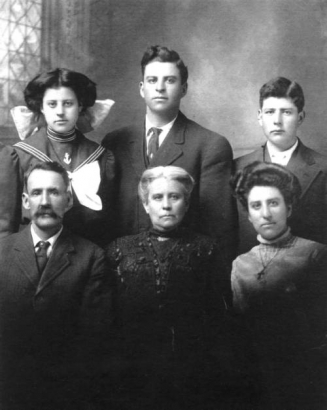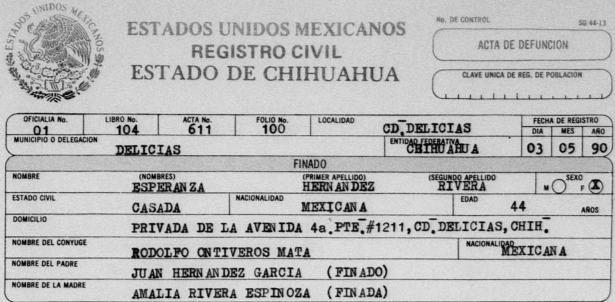When genealogists and historians research Spanish-surnamed ancestors and families, they may come across naming conventions, traditions, and customs that differ from English-speaking families. While there are variations in different locations, time periods, and families, this article highlights two of the more common differences researchers may encounter.
A major difference researchers encounter is the number of surnames. In Spain and Spanish American countries, except Argentina, each person has two surnames. Traditionally, the first surname is paternal and comes from the father, while the second surname is maternal and comes from the mother. In recent years, some countries have allowed parents to alter the order of surnames for their children, but in historical records paternal surnames generally precede maternal names. Some of the Spanish records in Arizona, California, Colorado, Florida, New Mexico, Puerto Rico, and Texas may use two surnames, although this varies by time period.
The death certificate of Esperanza Hernández Rivera from Delicias, Chihuahua, Mexico, is an excellent example. The certificate uses “apellido,” the Spanish word for surname, last name, or family name in English. Hernández is the paternal surname Esperanza inherited from her father and Rivera is the maternal surname she inherited from her mother. Vocabulary may vary in records and researchers may see “paternal/maternal surname” or “first/second surname” or simply “apellidos” in the plural.
The death certificate lists Esperanza’s father as Juan Hernández García and her mother as Amalia Rivera Espinoza and confirms the paternal and maternal surnames. The fact her parents also have both surnames recorded offers valuable clues for researchers who want to trace this family back another generation. Since Juan inherited Hernández from his father and García from his mother, the researcher knows the surnames of Esperanza’s grandparents. This information can be used to find Juan’s correct birth record, which could be tricky since "Juan Hernández" is a common name. By knowing that García is Juan's maternal surname, researchers can avoid confusing Esperanza’s father with another Juan Hernández. The term “finado” in parenthesis means they are deceased.
Just about every person listed on Esperanza’s death certificate – from witnesses to the government official certifying it – has two surnames listed. While this is the norm on legal documents, official papers, and vital records, in everyday life it is common to only use a paternal surname. For example, the Spanish actress Penélope Cruz often omits her maternal surname Sánchez and the Mexican soccer player Rafael Márquez does not have his maternal surname Álvarez printed on his jersey.
Another important Spanish-speaking naming custom is that women usually do not change their surnames when they marry. In our example, we see that Esperanza has kept her maiden name of Hernández even though the certificate states she was “casada” (married) and her “cónyuge” (spouse) was Rodolfo Ontiveros Mata. Women keeping their maiden names is helpful when sorting through records where couples have the same names as contemporary neighbors, such as census records.
In a local example, Policarpio Córdova and his family took a family photo in Trinidad, Colorado, in the early part of the 20th century. He is seated to the left of his wife who is listed as Gumucinda Chacón – not Córdova – and they are surrounded by their children: Isabel, Rosa, Amadeo, and Policarpio Córdova, Jr.
Nevertheless, there are women who do adopt their husband’s surname. Some replace their maiden name, as is customary in English-speaking countries, while others add “de” – meaning “of” – between the surnames. For example, Cristina Fernández was the first lady, vice-president, and president of Argentina. She was married to Néstor Kirchner, now deceased, and goes by Cristina Fernández de Kirchner.
When people with two surnames from Spanish-speaking countries emigrate to countries where one surname is custom, they have several choices. Some will drop one surname, usually the maternal or second surname. Others may choose to hyphenate their names. In the first example, Esperanza could have gone by Esperanza Hernández or Esperanza Hernández-Rivera in the United States, or even Esperanza Ontiveros if she had adopted her husband’s surname. To avoid missing any records, good researchers would look up all these variations in their research.
As researchers encounter different naming customs in their work, it is important to be familiar with differences. This helps to avoid mistakes, focus on the correct families, and save time. It also fosters an appreciation and respect for different cultures, traditions, and customs.




Comments
Hi Mel. Thank you for reading
Hi Mel. Thank you for reading! The answer to your second question is they'd be your first cousin once removed. Your children would be their second cousins.
Looking at the first part of your question, I am not finding an immediate answer. "E" and "da" are common prepositions you see in Portuguese surnames, but I am not finding a preposition or abbreviation for "R." You might find helpful information on the Familysearch page on Brazilian genealogy here: https://www.familysearch.org/en/wiki/Brazil_Personal_Names.
I will investigate further and keep you posted!
So if mother Hernandez…
So if mother Hernandez Garcia and father Lopez Sanchez is then the child will be Lopez Garcia & the subsequent grandchild would be Lopez XXXXX ?
No, Tony, the child would be…
No, Tony, the child would be Lopez Hernandez. Yes the grandchild would be Lopez XXXX. The father’s and mother’s paternal last name gets passed to the child. The article makes it sound more complicated than it is, basically everyone in the world has two last names it’s just not customary to use both. It’s simple, a child takes the father’s last name and the mother’s maiden name so if your dad’s last name is Jones and your mom’s maiden name is Smith then your name is Tony Jones Smith. Your child’s name would be Child Jones YourWifeMaidenName.
Great article... the main…
Great article... the main problem of having two last names is how they are read or recognized in USA. As an example in the article, "Esperanza Hernández Rivera" will be called as Mrs. Rivera. Unfortunately her last name Hernandez will be recognized as her middle name. This can be a big challenge. I decided to dropped my second last name to avoid all kind of problems with my job, banks, etc. My mom was very sad that I erased her from my Id's but at the end she understood that it was the best for me and that doesn't meant I didn't love her family. Plus my full name will be in my passport and birth certificate for ever.
When in Rome do as Romans do…
When in Rome do as Romans do. You’d be surprised how many times I’ve had to explain to people that the person with a last name of Perez-Linares as an example, the last name starts with Perez not Linares. Americans with no knowledge of this think of Perez as a middle name. Why complicate life for you and your child?
When in Rome do as Romans do…
When in Rome do as Romans do. You’d be surprised how many times I’ve had to explain to people that the person with a last name of Perez-Linares as an example, the last name starts with Perez not Linares. Americans with no knowledge of this think of Perez as a middle name. Why complicate life for you and your child?
Is Argentina a Spanish…
Is Argentina a Spanish American country? I ask because they speak Portuguese there.
This was really helpful and…
This was really helpful and clear explanations
I gave my kids both last…
I gave my kids both last names as their surname, no hyphen because I hate it. I just explain it to people or wherever I need to. I even printed and laminated it when people need to input it on a computer or anything and I wrote, no hyphen. It's part of our culture and people can learn something. Just as simple/difficult as people using "von" whatever or "O'Shea".
Like when the ask in maiden…
Like when the ask in maiden name what you have to get to them !?
Add new comment